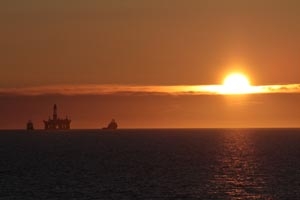Rosneft and ExxonMobil Start Drilling in the Kara Sea

 Rosneft and ExxonMobil joint venture company Karmorneftegaz began drilling at Universitetskaya-1, the Russian Federation's northernmost well using the West Alpha rig.
Rosneft and ExxonMobil joint venture company Karmorneftegaz began drilling at Universitetskaya-1, the Russian Federation's northernmost well using the West Alpha rig.
The signal to begin drilling was given by Russian President Vladimir Putin in a video link to the Kara Sea with the head of Rosneft Igor Sechin and the head of ExxonMobil Russia Glenn Waller. Special representative of President of the Russian Federation on international cooperation in the Arctic and Antarctic Artur Chilingarov and North Atlantic Drilling representative Jan Tore Theimann also took part in the ceremony.
“The start of exploratory drilling in the Kara Sea is the most important event of the year for the global oil and gas industry. As a result of this work we hope to discover a new Kara Sea oil-bearing province. Developing of the Arctic shelf has a huge multiplicative effect on the whole Russian economy” – said Igor Sechin.
The West Alpha rig was provided by the Norwegian company North Atlantic Drilling which signed long-term agreements with Rosneft on 30 July 2014 for the offshore drilling. West Alpha was transported via the Barents, Pechora and Kara Seas and installed on the drilling site of the East Prinovozemelskiy-1 Licence Area in the Kara Sea. The drilling rig made the way of over 1900 nautical miles to reach its destination. The rig is 30,700 tons in deadweight, 70 m long, 66 m wide, the derrick hangs 108.5 meters over the main deck, and it drafts during drilling for 21.5 m.
The rig is held on the drilling site by an 8-anchor positioning system, which provides advanced stability for the rig. Most of the platform is outside the reach of waves, which are no impediment for the rig's operation. The maximum drilling depth of West Alpha is 7 km. The drilling will continue for two months.
 Rosneft and ExxonMobil experts spent several months preparing the rig for the Kara Sea drilling operation. West Alpha was upgraded to improve the overall reliability of its main and supplementary equipment and for all systems to be ready for low temperatures, including, most importantly, life support and evacuation systems.
Rosneft and ExxonMobil experts spent several months preparing the rig for the Kara Sea drilling operation. West Alpha was upgraded to improve the overall reliability of its main and supplementary equipment and for all systems to be ready for low temperatures, including, most importantly, life support and evacuation systems.
The rig is equipped with an innovative system for the monitoring of ice condition, icebergs detection and tracking of sea ice. It uses infrared cameras and modern onboard radars, and analyzes satellite and air intelligence data.
To make sure West Alpha can operate safely in severe ice conditions, Rosneft and ExxonMobil developed a unique iceberg collision prevention plan. It even includes applying physical action to the ice. Should experts suspect a hummock or floe can damage the rig, special support vessels will tow it away to a safe distance. If physical action is impossible, the system will isolate the well in a way that is harmless for the environment, and the rig will transfer to a safer location. The rig is equipped with two groups of blowout preventers and an enhanced subsea shut-in device.
Notes for Editors:
The Universitetskaya structure covers an area of 1200 thousand kilometers with a 550 m high hydrocarbon trap. Its resources account to more than 1.3 billion tons of oil equivalent. A total of some 30 structures were found in three East Prinovozemelskiy areas of the Kara Sea, and the entire resource base of the three areas is estimated at 87 billion barrels or 13 billion tonnes of oil equivalent.
According to experts the volume of the Kara Sea oil province resources exceeds the oil and gas resources the Gulf of Mexico, the Brazilian shelf, the shelf of Alaska and Canada, and it will be comparable to the resource base of Saudi Arabia.
The sea depth at the drilling site is 81 m, and the designed depth of the vertical well is 2350 m from the rotary table. An Environmental Impact Assessment, an Oil Spill Response Plan and other pieces of project documentation were developed and approved by regulatory authorities for the project to proceed. The operations were preceded by public consultations, a State Environmental Expertise and a Main State Expertise.
Rosneft and ExxonMobil are also working on the implementation of the approved strategy regarding other joint projects.
Rosneft Information Division
Phone: + 7 (499) 517-88-97
August 09, 2014
These materials contain statements regarding future events and expectations that in essence are the forward-looking statements. Any statement in these materials that is not a statement of historical fact is a forward-looking statement that involves known and unknown risks, uncertainties and other factors which may cause actual results, performance or achievements expressed or implied by such forward-looking statements to differ. We assume no obligations to update the forward-looking statements contained herein to reflect actual results, changes in assumptions or changes in factors affecting these statements.